
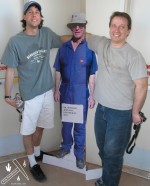
| Click the underlined links to navigate or the thumbnail photo to enlarge |
| Day One | St George Dinosaur Discovery Site at Johnson Farm | Pink Water Tank Site at Washington City | Warner Valley Site | |||
| Day Two | Pink Water Tank Site at Washington City (again) | Zion Park | Moqui Cave | Wire Pass | Grand Staircase via Cottonwood | Camped at Paria Camp Grounds - White House Trailhead |
| Day Three | Flag Point Track Site and Indian Pictograms | Explored K1-K2-K3 exposures along the Kolob Terrace section of Zion No photos or notes taken | Zion Park (again) | Warner Valley Site (again) | ||
Day One First Stop - St George Dinosaur Discovery Site at Johnson Farm
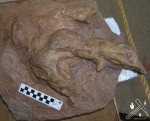

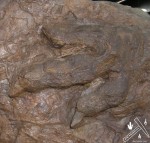
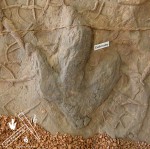





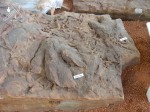
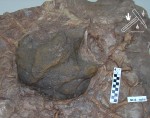

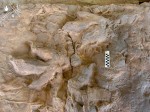
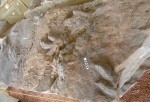
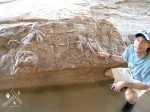

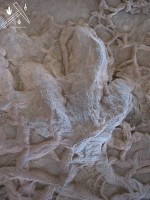
| ||||
| Various Eubrontes prints. |
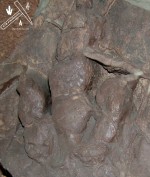
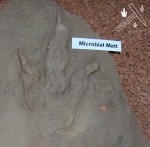
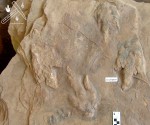



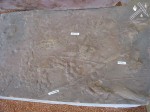
| ||||
| Various Grallator prints. |
 |
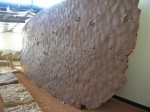 |
 |
 |
 |
| The left side view of the giant slab with Grallator trackways. |
The right side view of the giant slab with Grallator trackways. |
The front view of the giant slab with Grallator trackways. |
Eight trackways highlighted. |
John and Henry imagining how the slab was moved to this location if not for heavy equipment. |
 |
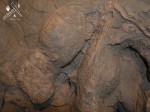 |
 |
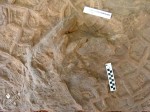 |
 |
| The skin impression of a Eubrontes. |
A close-up of the same skin impression. |
Another angle view of the same skin impression and scale scratch lines. |
A Grallator print inside a Eubrontes print. |
The metatarsal print of a Eubrontes. |
  |
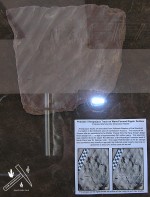 |
 |
 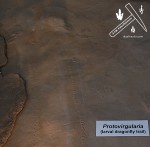 |
 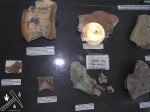 |
| Radial desiccation cracks caused by the weight or pressure of the foot on the mud. |
Possible Therapsipus track on ripple rock. |
Parallel scratch marks caused by a swimming creature. |
Insect traces. |
Misc fossils found in Utah. |
Day One Second Stop - Pink Water Tank Site at Washington City
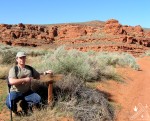 |
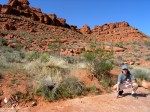 |
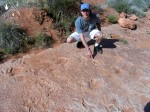 |
|
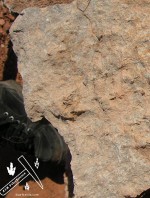 |
||
| Henry pointing the way to the tracks. |
John finds the tracks. |
... a whole lot of tracks. |
Henry finds one huge Eubrontes on sandstone. |
And a small Grallator. |
|
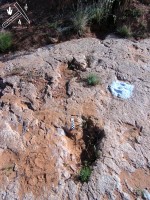
 |
The Pink Water tower site where we had to hike up the mountain about a mile to a white limestone band of the
Kayenta formation. Here there were many mid sized Eubrontes-like tracks about 25 or so and then a single trackway of a very large Eubrontes-like trackway
with excellent metatarsal impressions. Compared to the tracks all around these tracks, it is suggested that this dinosaur that left the metatarsal
tracks was definitely a big guy with a lot of weight under his belt. Later we scanned the area and hills around the tracksite and did manage to find
a few more tracks on loose rocks in the area but none like the main trackway area. |
Two views of a very large Eubrontes-like trackway with excellent metatarsal impressions and with a relatively short step.
|
|||
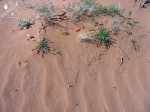

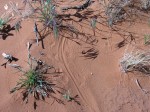
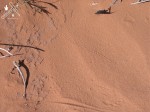
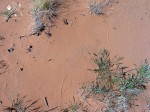
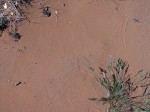
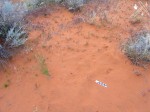
|
Photos of modern tracks from reptiles and insects exhibiting discontinuation, ripples, tail & body drag marks. |
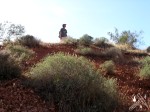 |
|
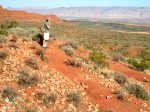 |
|||||
| John striking a famous pose. |
...describe geo strata... |
John smells prints over the next mountain range. |
|||||
Day One Third Stop - Warner Valley Site
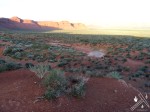 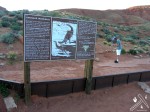 |
| |||||||||||
| The Warner Valley Site from a distance and up close. Excuse the error in the sign. The larger prints are not prosauropod because they had 5 toes, and no 5 toed prints are found here. These three toed prints are known as Eubrontes (larger ones) and Grallator (smaller ones). |
|
|||||||||||
  |
|
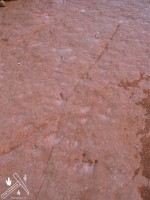 |
 |
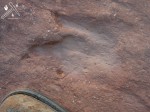 |
||
| A Eubrontes print. Typically prints in-situ are molds and not raised (cast) liked this one. Interestingly, the cast was preserved and imbedded in the mold of the print. |
Part of a Grallator trackway we found, further downstream, with 5 or 6 Grallators in a row and amazingly deep. These tracks were about 2 to 3 inches deep!!! This suggests the mud was much softer here than upstream. I.e., deeper tracks created by a lighter smaller creature. |
Part of the 17 print Grallator trackway. |
One print of a 17 print Grallator trackway. |
Close-up of the same print. |
| Day One | St George Dinosaur Discovery Site at Johnson Farm | Pink Water Tank Site at Washington City | Warner Valley Site | |||
| Day Two | Pink Water Tank Site at Washington City (again) | Zion Park | Moqui Cave | Wire Pass | Grand Staircase via Cottonwood | Camped at Paria Camp Grounds - White House Trailhead |
| Day Three | Flag Point Track Site and Indian Pictograms | Explored K1-K2-K3 exposures along the Kolob Terrace section of Zion No photos or notes taken | Zion Park (again) | Warner Valley Site (again) | ||
Special Thanks
To the folks and volunteers of the St George Dinosaur Discovery Site at Johnson Farm, the office of BLM, and Moqui Cave.
Back to the Paluxy River, near Glen Rose Texas
Back to Sheldon Johnson's Farm in St. George UT
This is the 'UT 2006 Dino Tracksite Trip' page
Back to the Mastodon Dig in San Jose, CA
Back to Glacier National Park, MO
Back to Strataman's Fossil Store